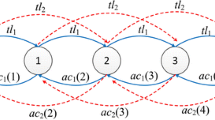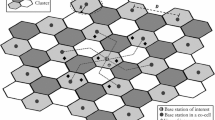Abstract
This paper presents a simulation-based study of cellular packet CDMA systems operating in an integrated voice/data traffic scenario. Spread-spectrum CDMA provides a suitable framework for resource-shared packet transport capable of combining isochronous (voice, ISDN) and bursty data services. In this work, a general network model for cellular packet CDMA with mixed voice/data traffic is described and used to evaluate the capacity/performance impact of several key system parameters. First, the effect of spreading factor (N) and forward error correction (FEC) rate are studied, confirming earlier work indicating a weak dependence onN and a well-defined optimum code rate in the range of 0.5–0.7 (with BCH coding). Next, the effect of propagation loss coefficient (γ) on network capacity is investigated over a range of possible assumptions forγ, including both constant and distance-dependent models. The results show that system capacity depends strongly onγ, varying by as much as a factor of 2 over the range of parameters considered. For a given distance-dependentγ assumption, performance results are also obtained for different cell sizes in order to understand the overall spatial reuse efficiency achievable in different cellular and microcellular scenarios. This is followed by an investigation of traffic source model effects: first the capacity improvement from voice activity detection VAD) is presented, showing the expected ∼2∶1 gains. Results for varying proportions of voice and data traffic intensities indicate that the operating efficiency does not change significantly as the proportion of bursty data relative to voice is varied.
Similar content being viewed by others

References
G. R. Cooper and R. W. Nettleton, Cellular mobile technology: the great multiplier,IEEE Spectrum, Vol. 20, No. 6, pp. 30–37, 1983.
J. T. Taylor and J. K. Omura, Spread spectrum technology: a solution to the personal communications services frequency allocation dilemma, IEEE Communications Magazine, Vol. 29, No. 2, pp. 48–51, 1991.
A. J. Viterbi, Wireless digital communications: a view based on three lessons learned,IEEE Communications Magazine, Vol. 29, No. 9, pp. 33–36, 1991.
K. S. Gilhousenet al., On the capacity of a cellular CDMA system,IEEE Transactions on Vehicular Technology, Vol. VT-40, pp. 303–312, 1991.
D. C. Cox, Personal communications—a viewpoint,IEEE Communications Magazine, Vol. 28, No. 11, pp. 8–20, 1990.
D. J. Goodman, Trends in cellular and cordless communications,IEEE Communications Magazine, Vol. 29, No. 6, pp. 31–40, 1991.
K. Pahlavan, Wireless communications for office information networks,IEEE Communications Magazine, pp. 19–27, 1985.
Special Issue on Digital Cellular Technologies,IEEE Transactions on Vehicular Technology, Vol. 40, No. 2, 1991.
D. Raychaudhuri, Performance analysis of random-access packet-switched code division multiple access systems,IEEE Transactions on Communications, June, pp. 895–901, 1981.
A. Polydoros and J. Silvester, Slotted random access spread-spectrum networks: an analytical framework,Journal on Selected Areas in Communications, July, pp. 989–1002, 1987.
N. Wilson, R. Ganesh, K. Joseph and D. Raychaudhuri, CDMA versus Dynamic TDMA for access control in an integrated voice/data PCN,IEEE Journal on Selected Areas in Communications, August, pp. 870–884, 1993. (also inProc. 1st International Conf. on Universal Personal Communications, Sept. 28–Oct. 1, 1992).
K. Zhang and K. Pahlavan, An integrated voice/data system for mobile indoor radio networks,IEEE Transactions on Vehicular Technology, Vol. 39, No. 1, pp. 75–82, 1990.
D. Raychaudhuri and N. Wilson, Multimedia personal communication networks: system design issues,Proc. 3rd WINLAB Workshop on Wireless Information Networks, April 28–29, 1992, pp. 259–288.
J. Musur and J. Daigle, Throughput analysis of an asynchronous code division multiple access (CDMA) system,Proc. ICC 1982, June 1982, pp. 2F2.1–7.
R. L. Pickholtzet al., Spread spectrum for mobile communications,IEEE Transactions on Vehicular Technology, Vol. VT-40, pp. 313–322, 1991.
K. Joseph and D. Raychaudhuri, Performance evaluation of cellular packet CDMA networks with transmit power constraints.Proc. ICC 1991, June 1991, pp. 50.3.1–7.
F. Simpson and J. M. Holtzman, CDMA power control, interleaving and coding,Proc. 41st IEEE Veh. Tech. Conf., May 1991, pp. 362–367.
S. Soliman, C. Wheatley, and R. Padovani, CDMA reverse link open loop power control,Proc. IEEE Globecom 1992, pp. 69–73.
R. Ganesh, K. Joseph and D. Raychaudhuri, Effect of propagation loss coefficient on the performance of a packet CDMA PCN,Proc. PIMRC'92, Oct. 1991, pp. 11.6.1–5.
W. C. Y. Lee, Overview of cellular CDMA,IEEE Transactions on Vehicular Technology, Vol. VT-40, pp. 291–302, 1991.
Special Issue on Mobile Communications.British Telecom Tech. Journal, Vol. 8, No. 1, 1990.
S. Nanda, D. J. Goodman, and U. Timor, Performance of PRMA: a packet voice protocol for cellular systems,IEEE Transactions on Vehicular Technology, Vol. VT-40, pp. 584–598, 1991.
P.-C. Wong and T.-S. P. Yum, An integrated services tokencontrolled ring network,"IEEE Journal on Selected Areas in Communications, Vol. 7, pp. 670–679, 1989.
J. G. Gruber, A comparison of measured and calculated speech temporal parameters relevant to speech activity detection,IEEE Transactions on Communications, Vol. COM-30, 1982.
L. B. Milstein,et al., On the feasibility of a CDMA overlay for personal communications networks,IEEE Journal on Selected Areas in Communications, Vol. 10, pp. 655–668, 1992.
P. Harley, Short distance attenuation measurements at 900 MHz and 1.8 GHz using low antenna heights for microcells,IEEE Journal on Selected Areas in Communications, pp. 3–11, Jan. 1989.
J. H. Whitteker, Measurements of path loss at 910 MHz for proposed microcell urban mobile systems,IEEE Trans. on Vehicular Technology, Vol. 37, No. 3, pp. 125–129, 1988.
T. S. Rappaport and L. B. Milstein, Effects of path loss and fringe user distribution on CDMA cellular frequency reuse efficiency,Proceedings of the IEEE GlobeCom 1990, pp. 404.6.1–404.6.7.
A. Carlieal and M. Hellman, Bistable behavior of Aloha type systems,IEEE Transactions on Communications, April, pp. 401–410, 1975.
K. Joseph and D. Raychaudhuri, Stability analysis of asynchronous random access CDMA systems,Proc. Globecom 86, Dec. 1986, pp. 1740–1746.
D. Raychaudhuri, Stability, throughput and delay of asynchronous selective reject ALOHA,IEEE Transactions on Communications, July, pp. 767–772, 1987.
K. Joseph and D. Raychaudhuri, Analysis of generalized retransmission backoff policies for slotted Aloha multiaccess channels,Proc. ICC, 1988, pp. 430–436.
D. Raychaudhuri and K. Joseph, Performance analysis of slotted Aloha with generalized retransmission backoff,IEEE Transactions on Communications, January, pp. 117–122, 1990.
D. Raychaudhuri and J. Harman, Dynamic performance of ALOHA-type VSAT channels: a simulation study,IEEE Transactions on Communication, February, pp. 251–259, 1990.
K. Joseph and D. Raychaudhuri, Analysis of asynchronous random access spread spectrum with block forward error correction,Proc. ICC 89, pp. 1269–1277.
Author information
Authors and Affiliations
Rights and permissions
About this article
Cite this article
Ganesh, R., Joseph, K., Wilson, N.D. et al. Performance of cellular packet CDMA in an integrated voice/data network. Int J Wireless Inf Networks 1, 199–222 (1994). https://doi.org/10.1007/BF02107419
Issue Date:
DOI: https://doi.org/10.1007/BF02107419



